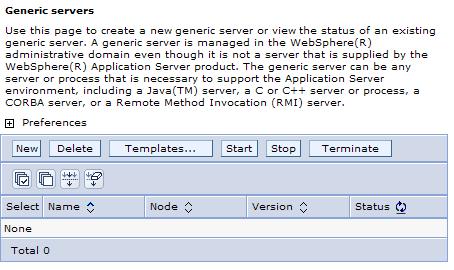Server collection
Use this page to view information about and manage appservers, JMS servers, and Web servers.
For the ND product, you can also use this page to view information about and manage generic servers.
Application servers
The Application servers page lists the appservers in the cell. You can use this page to start and stop these appservers.
If you are using the ND product and have created clusters, you can also use this page to manage appservers that are cluster members if the Include cluster members in the collection console page preference is selected. When this preference is selected, a Cluster Name column is included in the appserver information table. If an appserver is part of a cluster, the Cluster Name column specifies the name of that cluster. If this preference is not selected, the Cluster Name column does not appear in the table and appservers that are cluster members are not listed in the list of appservers and cannot be managed from this page.
If you are using the ND product, this page also displays the status of the appservers. The status indicates whether a server is running, stopped, or encountering problems. You can also use this page to create new appservers, create appserver templates, or delete existing appservers.
To view this console page, click...
Servers | Application servers
Generic servers
The Generic servers page is only available for the ND product. This page lists the generic servers in the cell and displays the status of these generic servers.
The status indicates whether a server is running, stopped, or encountering problems. You can use this page to start and terminate these generic servers. You can also use this page to create...
- New generic servers
- Create generic server templates
- Delete existing generic servers.
However, the Stop and Stop Immediate buttons on the console do not work for generic servers.
To view this console page, click...
Servers | Generic servers
Java message service (JMS) servers
The JMS servers page lists the JMS servers in the cell. You can use this page to start and stop these JMS servers. Each JMS server provides the functions of the JMS provider for a node in your administrative domain. There can be at most one JMS server on each node in the administration domain, and any appserver within the domain can access JMS resources served by any JMS server on any node in the domain. To view this console page, click...
Servers | JMS servers
JMS servers apply only to WAS V5.x nodes. You cannot create a JMS server on a node that is running WAS 6.x, but the existing V5.x JMS servers continue to be displayed, and you can modify their properties. However, you cannot use this page to delete a V5.x JMS server.
Web servers
The Web servers page lists the Web servers in your administrative domain. You can use this page to generate and propagate a Web server plug-in configuration file, create new Web servers, create new Web server templates, or delete existing Web servers. You can also use this page to start and stop these Web servers. To view this console page, click...
Servers | Web servers.
Name Specify a logical name for the server. For WAS, server names must be unique within a node.
Node Name of the node holding the server. V Specify the version of the WAS product on which the server runs.
Status This field only displays for the ND product. It Indicates whether the server is started or stopped.
Note that if the status is Unavailable, the node agent is not running in that node and restart the node agent before you can start the server.
Sub-topics
Application server settingsGeneric server settings
Related tasks
Manage appservers
Related Reference
Object names: What the name string cannot containNode agent collection
V5 JMS server settings nbsp;
Related information
V5 JMS server collection
